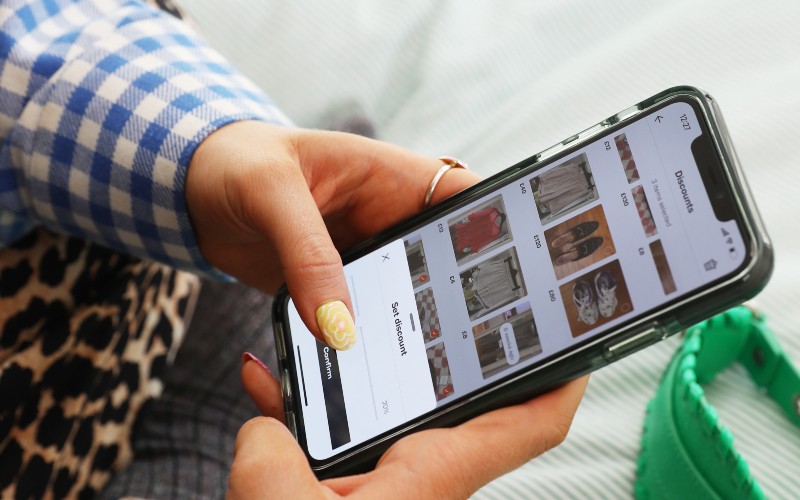Get your price right
HOW TO PRICE A PRODUCT ON DEPOP
Did you know that price is one of the main reasons why shoppers choose to shop secondhand? So that means how you price your items on Depop is really important if you want to make a sale.
In this article, we offer the ultimate guide to setting a smart pricing strategy for your Depop shop. You’ll find some great tips on what to consider when setting your prices, and how to price effectively for maximized sales with this in-depth price guide.
Pricing products on Depop
Choosing the right price for your item is one of the most important parts of a successful listing on Depop. You could have the perfect item for a particular buyer, but if it’s priced too high it might be difficult to make the sale. But how do you learn how to price an item on Depop? Whatever you’re selling, we’ve got some top tips that will help you decide how to price your product. Our quick-reference pricing checklist is a great starting point.

Our Quick Pricing Checklist
- Research the Market
Make sure to do your market research. Buyers expect, on average, to spend 25% less on secondhand clothing (Source: Zogby Analytics consumer survey, September 2021, n=2,009). Even if your item is new with tags or like new, buyers will likely expect to pay less than if they had purchased the item new directly from a retailer.
- Think About Condition
If your item has any damage, marks or stains, remember to reflect these flaws in its price - use the condition tag.
- Discounting
Consider adding a discount to items that don’t seem to sell.
- Be open to offers
Respond when buyers make an offer.
Please note: Whilst we are able to share our top tips for listing on Depop on the basis of our experiences and the feedback we get from our sellers, we do not make any guarantee or representation or accept any liability in relation to the sales or revenues to be gained as a Depop seller.
Your selling price strategy
When it comes to figuring out pricing for a product, there are a few key things to keep in mind. Factors like your item’s condition, how rare it is and how in-demand it is will all play a role in determining its selling price. But if your aim is to clear out your wardrobe and get
things moving, it’s a good idea to price competitively to make your item appealing for your buyer. Consider whether you've overpriced your item, as this could be a reason for the item not selling quickly (note, on average, we do see higher listing prices for unsold items).
How to price your product
Setting your product’s price may first seem like a daunting or complicated thing to do. But there are a few easy steps that you can take to help calculate a perfect price for your item.

1. Research the market
So you’ve got an item you’re ready to list. The first thing to do is have a look around Depop to see how other sellers are pricing similar items. Search for items like yours and compare them, things like brand, condition, material, age and signs of wear. Then, consider whether you want to be competitive and perhaps price your item lower, to make it even more tempting for buyers.
Remember that price is one of the main reasons why buyers choose to shop secondhand (Source: GlobalData 2022 Resale Consumer Survey). Buyers expect, on average, to spend 25% less on secondhand clothing (Source: Zogby Analytics consumer survey, September 2021, n=2,009). Even if your item is new with tags or like new, buyers will likely expect to pay less than if they had purchased the item new directly from a retailer.
2. Think about condition
If your item has any damage, marks or stains, remember to reflect these flaws in its price. When pricing a product for resale, these things really do matter. Simply put: an item in perfect condition is more valuable than an identical item with damage and wear.
Also, if you’re selling an item with signs of wear or damage, make sure to add this info to your listing description so buyers can know exactly what to expect. Try using the Condition tag when listing to get specific.

3. Be open to offers
Once you’ve settled on a price that’s right for you, you’re ready to list your item. But keep in mind that there are other ways to find the right price for your buyer, too. With Depop’s Make Offer feature, you’ve got room to negotiate with your buyers. Prospective buyers can send offers for your items, and if you like, you can negotiate with them by making a counteroffer. You might want to use the value of offers you receive as a cue for whether your item is overpriced. For example, if you price something at £20 and you are getting lots of offers between £12-£15, you may want to adjust your listing price.
4. Offering discounts
If you’ve got a great item that doesn’t sell, it could be time to consider a discount. We’ve made it easy for you to pick a percentage to discount your items, anywhere from 5% to 50%, and then apply it to any items you’d like [using the discount feature in the Seller’s Hub]. This way, you can discount as many items as you like in one go to get your stock moving. If a buyer has saved or liked an item of yours and you apply a discount to it, they’ll get a notification to alert them it’s now available for less.
@minisworld
When it comes to choosing when to run a discount, have a look at the rest of the market. Keep an eye out for Cyber Week or seasonal promotions, because lots of sellers will choose to discount items then and Depop regularly curates seller’s promotions based on these. To keep updated, make sure you opt-in to Depop’s emails and notifications and we’ll tell you when we and how we plan to publicize seller promotions.
Negotiating on Depop
Sometimes when selling your products, buyers may request to offer you a different price than the one you have advertised. Thanks to our “Make Offer” feature, there’s often room for negotiation when selling something on our platform. But you may be wondering how to negotiate on Depop smartly and successfully. Take a diplomatic, polite and mindful approach. If a seller is open to accepting lower offers, they’ll have included this button on their listing. Click it and you’ll have the option to manually enter the offer you’d like to submit. The seller can then consider your offer and decide if they’re happy to accept it. If they do, you’ll then receive a notification to pay for the item before it’s shipped to you. If the button isn’t there to tap, you could always send the seller a private message asking if they’d be open to negotiating on the selling price. There’s no guarantee of course, but it doesn’t hurt to ask. Negotiating on Depop is a great way for buyers to save some extra money and for sellers to shift an item that may not be getting as much interest as they expected. So use it to your advantage when necessary.
Pricing a product - recap
To summarize, pricing your items correctly is a key part of running a successful Depop shop. Doing your research and experimenting with discounts can be great ways to make sure your items sell. Don’t forget: pricing right is just one part of a successful Depop shop. Acing your item’s listing and making sure shipping is smooth and easy can also help you make the sale and keep your buyers happy.
Want to learn more? Sign up to our Level Up program - a free online interactive education program open to sellers looking to improve their Depop shop.